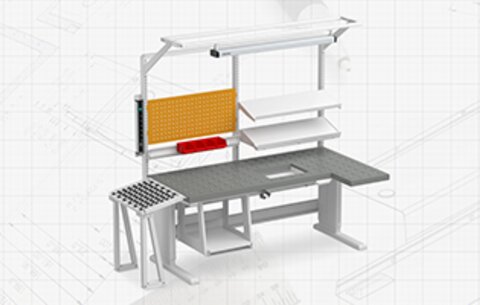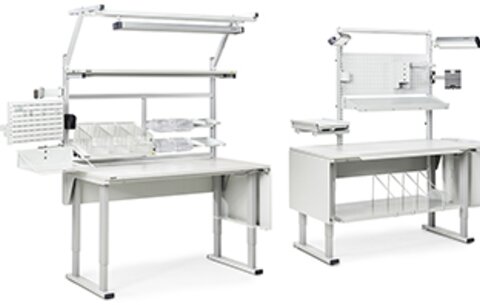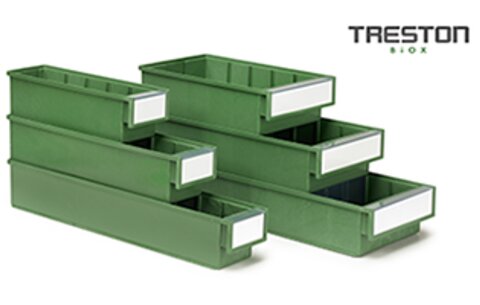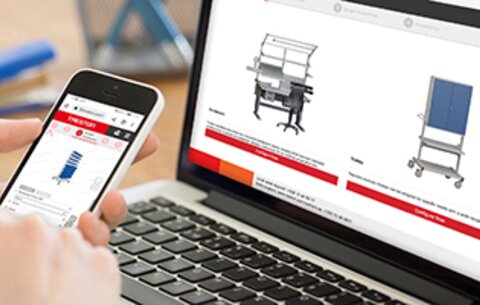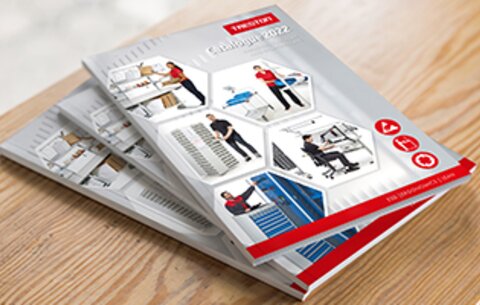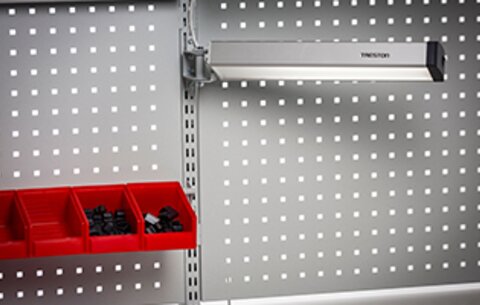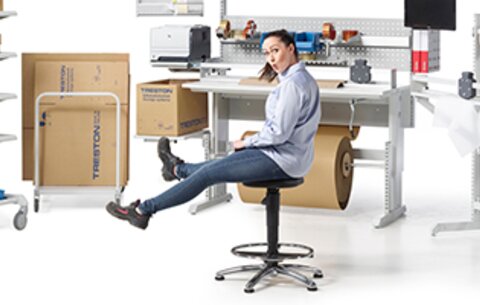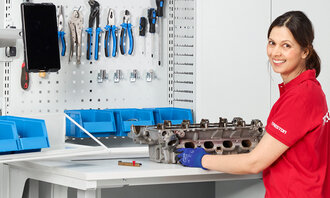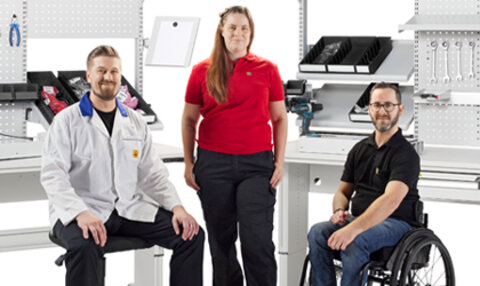

How to choose the right adjustable workbench
In this article, we’ll guide you through the choosing process of an adjustable industrial workbench.
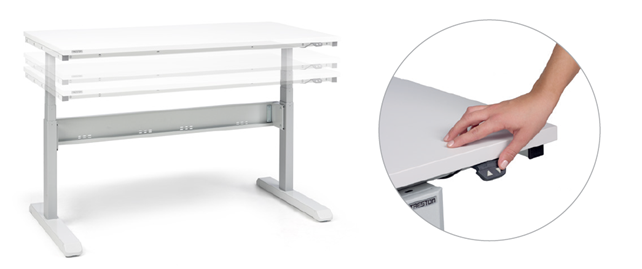
Should the workbench be designed for sitting or standing?
The choice of a seated or standing working posture is dependent upon the task to be executed. The height of the work surface is determined by such factors as size and weight of the part, precision requirement, assembly process, repetitiveness etc. Height adjustability is especially useful when the size of the products being handled varies or when several people use the same workstation.
If tasks require paperwork, typing, no heavy lifting, and/or all tools for the job are provided in arm’s reach, then the workstation should be designed for sitting, but with possibility to stand.
Don't forget the opportunity to rest, especially during heavy work.
If tasks require lifting heavy loads, continuous movement, parts retrieval, and/or there is no leg space, then the workstation should be designed for standing but with the possibility to rest every now and then, whenever possible.
General guidelines for the choice of the posture
| Task | Primary choice | Secondary choice |
| Lifting the weight over 5 kgs | Standing | Semi-sitting* |
| Working below the elbow level | Standing | Semi-sitting* |
| Need to reach widely in horizontal level | Standing | Semi-sitting* |
| Light assembly work | Sitting | Semi-sitting* |
| Precision work | Sitting | Semi-sitting* |
| Visual monitoring or supervising | Sitting | Semi-sitting* |
| Need to move between workstations | Semi-sitting* | Standing |
*Semi-sitting work is between sitting and standing. Semi-sitting reduces the strain of the back due to sitting and the strain of the lower limbs due to standing.
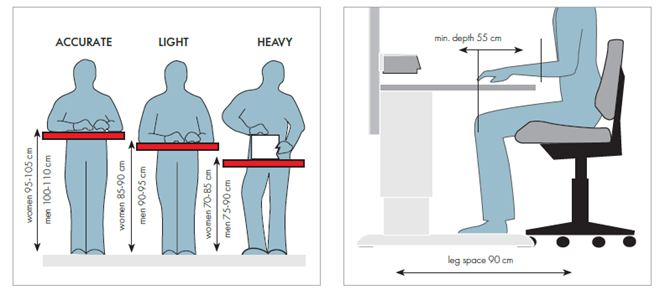
What is the optimal working height for a workbench?
When sitting, a desk surface should typically be 63 to 76 cm high for writing and typing and can be positioned as much as 25 cm higher if tasks demand an elevated platform. Depending on personal preference, the surface should offer the versatility to be lowered 5 cm to accommodate for body size.
When standing, the desk should be 76 to 114 cm high, and, once again, able to adjust to 5 cm lower if needed. The adjustments here are critical so as to cater to various heights and body types. Ensure it’s comfortable to rest arms, reach products, or see a monitor. Most often it’s good to avoid overly large or deep workbenches. One option is to favour customised tables.
Consider the individual differences of industrial work
It’s important to remember that ergonomics does not create a rigid solution for one particular person. Most production teams have a diverse set of workers. Different physiques, arm length, abilities, skill levels and vision strength have to be accommodated. True ergonomically friendly work environments are made in such a way to offer flexibility, adjustability and customisation. That means the strongly-built, 6’5’’ male worker may be at the same workstation during one shift as a petite, slender, 5’2’’ female worker was in another. Ergonomic solutions recognise this and offer a solution that can accommodate all body-types.
Learn more about increasing productivity with proper ergonomics:
Download the free E-book
4 ways to adjust the height of the workbench
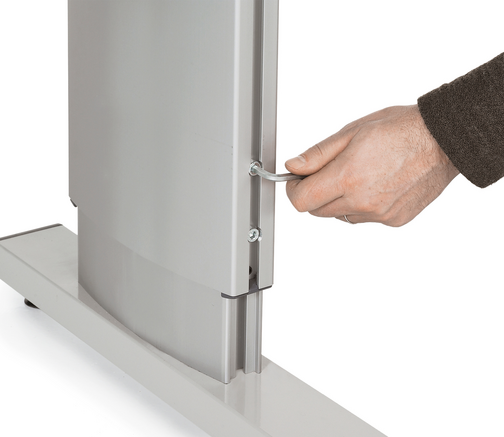
Allen-key adjustable workbench
The height can be adjusted electrically (electric motor height adjustment) or manually (with a hand crank or an Allen-key). An industrial workbench with Allen-key adjustment is best suited when height adjustment is only rarely needed.
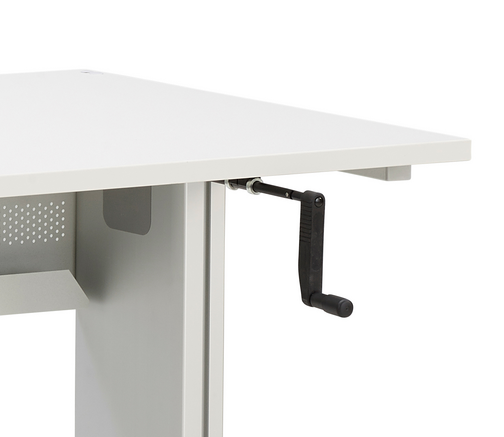
Hand crank adjustable workbench
A hand crank adjustable workbench is suitable for workstations where the height is only adjusted once or twice a day, e.g. when changing shifts. Adjusting the height with hand crank is easier than in Allen-key adjustable models, but not as quick and smart as in electric workbenches.
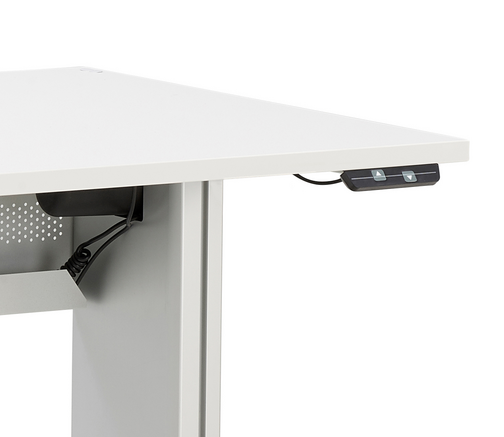
Electrically adjustable workbench
The electrically adjustable workbench allows you to change the posture several times during the work shift, as it can be easily and quickly adjusted for each employee and for varying working postures. The electronic adjustment is also used with a lower threshold, and the possibility of height adjustment is utilised more often.
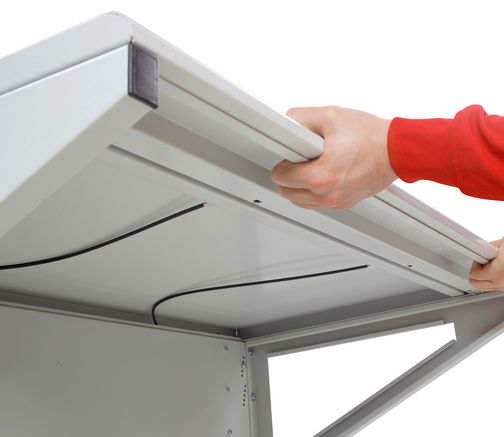
NEW! Extremely fast spring-adjustable workbench (Treston Quick Edge)
The height of the Treston Quick Edge workbench is adjusted with a non-electrical spring-adjust mechanism. The patented height adjustment solution minimizes the time required to adjust the height and thus makes daily work smoother, more efficient and more ergonomic.
Comparison of the Treston adjustable workbenches
|
Product |
Designed for |
Max load (Allen Key) |
Max load (Hand crank) |
Max load (Electric motor) |
Max load (Quick Edge) |
|---|---|---|---|---|---|
| Treston Concept | Assembly, Quality control, Packing / logistics | 500 kg | 200 kg | 400 kg | - |
| Treston WB | Electronics assembly, R&D, testing |
300 kg | 200 kg | 300 kg | - |
| Treston TED | Light-duty assembly, packing / logistics, industrial offices, R&D |
- | - | 200 kg | - |
| Treston Quick Edge | Packing / logistics | - | - | - | 100 kg |
Learn more about increasing productivity with proper ergonomics

